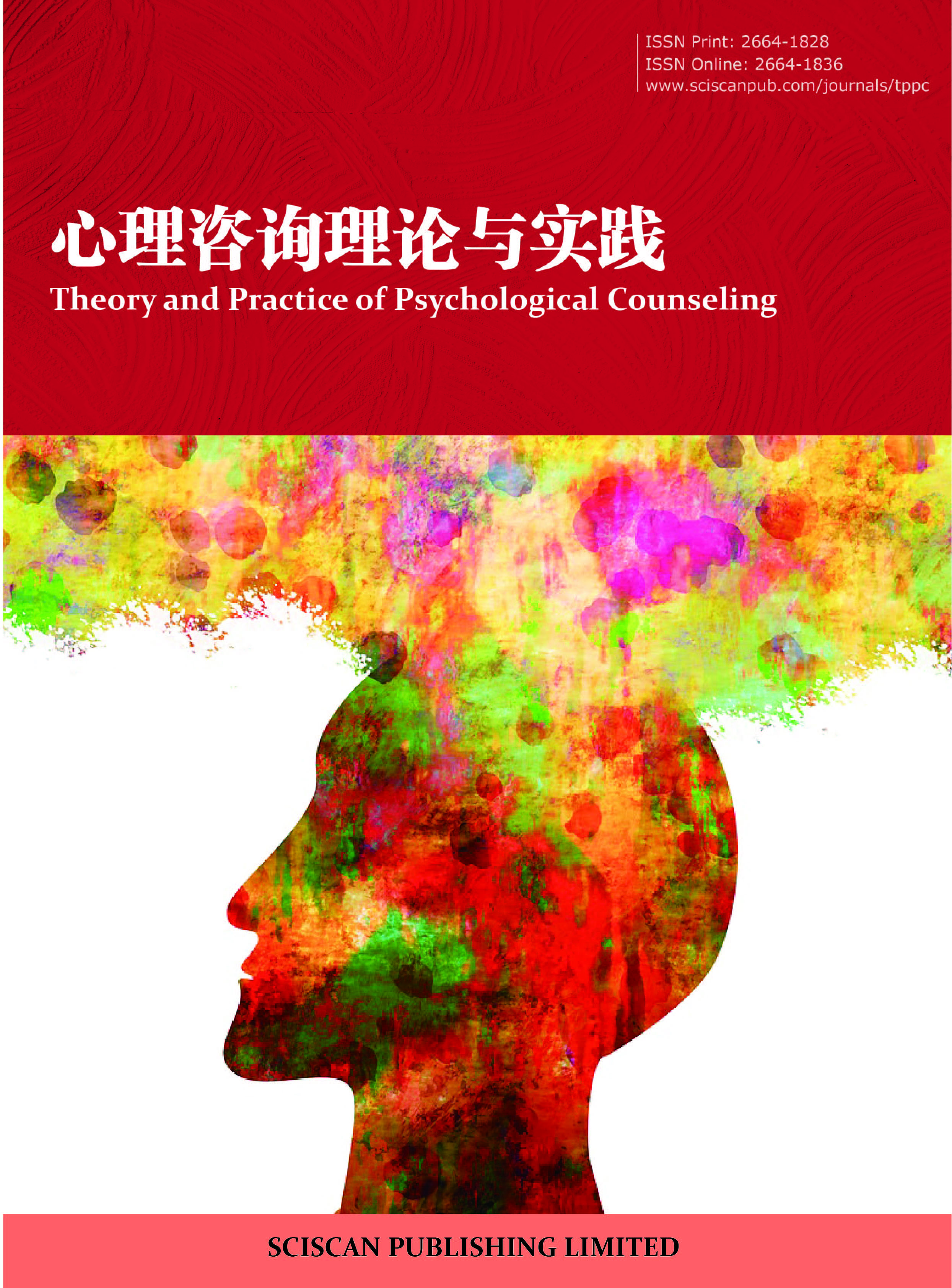Theory and Practice of Psychological Counseling
意象对话实践中对立意象的研究
Research on the Opposite Imagery in the Imagery Communication Psychotherapy
- Authors: 吴菻¹ 王丽² 张婍¹
-
Information:
1.北京联合大学师范学院心理系,北京; 2.鲁东大学教育科学学院,烟台
-
Keywords:
Opposite Imagery; Imagery Communication Psychotherapy; Psychological Counseling; Undergraduates对立意象; 意象对话疗法; 心理咨询; 大学生
- Abstract: Firstly, this study collates and reviews the concepts of image and symbol, and innovatively puts forward the concept of opposing image according to the practice of imagery communication psychotherapy. On the basis of summing up, this study tries to explore the characteristics and rules of College Students’ opposite imagery presentation. The results were as follows: (1) 90.5% of the subjects presented opposite imageries in the process of imagery communication psychotherapy, totally 20 pairs of opposite imageries; (2) the frequency of black and white pairs of imageries was the highest, accounting for 18.75% of the total sample; the frequency of light and dark pairs of imageries was higher, accounting for 14.06% of the total sample; the frequency of other opposite imageries was lower than that of the whole sample, which is 10%. Based on the above results, this paper explores the relationship between opposite imagery and Jung’s integration thought, the significance of the discovery of opposite imagery and the method and significance of the integration of opposite imagery. 本研究首先介绍了意象对话的研究背景及意义,整理和回顾了意象和象征的概念,根据过往研究和意象对话实践经验,创新性地提出了对立意象的概念。基于现有的研究成果进行归纳总结,并尝试探索大学生对立意象呈现的特点和规律。结果如下:(1)90.5% 的被试在意象对话的过程中都呈现出了对立意象,总共呈现了20 对相互对立的意象;(2)黑与白这对意象出现的频次最高,占整体样本的18.75%;明与暗这对意象出现的频次较高,占整体样本的14.06%;其他对立意象出现的频次较低,低于整体样本的10%。对立意象是普遍存在的,探究对立意象与荣格整合思想之间的联系、对立意象发现的意义以及对立意象整合的方法和意义。
- DOI: https://doi.org/10.35534/tppc.0312112
- Cite: 吴菻,王丽,张婍.意象对话实践中对立意象的研究[J].心理咨询理论与实践,2021,3(12):892-899.
1 引言
“意象”是指在人们想象中的,而不是真实存在的某个心理图像。意象是一种具有象征性的符号,通常以视觉的形式呈现,有时也会以听觉或其他感觉方式出现。因此,“意象”存在于我们的精神世界中,一般认为意象代表着无意识的语言即一种用独特的象征性符号进行无意识表达的语言,而正是因为它极具价值的象征性,才能够使它成为无意识语言中的重要构成内容[1]。1996年的《现代汉语词典》修订版有两个简洁关于“象征”的定义。一是 “用特定的东西表达特殊的意义”;二是反过来,“用来象征某种特别意义的具体事物”。在英文词典中的“symbol”(象征)一词有多个定义和界说,其中一个定义是“某种东西由于联系、想、习俗或偶然的类似而代表或暗示另外的东西,特指以有形喻无形”[2]。“symbol”英文释义的后半部分与中文定义相似,它们不约而同指出了象征的本质在于形象思维。借用象征,抽象深奥的概念变成了鲜活的可感可知的物体,如以“太阳”喻“希望”,以“蛇”表“邪恶”,其中“太阳”与“蛇”是特定的图像但人们却可以从特定的图像中观察到抽象的含义,即“希望”与“邪恶”。可以说象征是人类想象力的产物,它一定程度上反映了人类的内心世界与自然等外部世界之间的呼应和契合。不论是百兽、植被还是标记、符号、形状,一旦由具体形象上升为象征意象,它的意义和价值总是会超出其原始含义和原始价值。
意象对话技术基于意象,并使用人类原始认知的方法进行深层次交流,主要强调体验和互动。意象对话技术既受到精神分析、荣格分析心理学等西方心理学极大影响,同时又将东方传统文化中的要素渗入其中[1]。意象对话通常由心理咨询师和来访者两个主体,当心理咨询师和来访者处于意象对话情境中时,其二者之间的对话是在潜意识层面进行的,即咨询师在理性认知层面没有明确说明,但来访者的潜意识也是完全可以理解的。意象对话承继心理动力学流派,特别是荣格的观点,其中心命题是:人们的认知和情感活动不同于日常的逻辑思维。意象对话可以使用潜意识感知一个人使用符号图像想传达给另一个人的信息和情感,并不需要意识的参与。[3]意象对话技术作为一个新兴的技术,诸多学者对意象对话的理论研究都为意象对话技术的临床实践提供了有力的支持。贺佳将意象对话疗法与问卷法相结合,探究了意象对话疗法中被试房屋意象与自我意识的状态、大五人格之间的关系[4]。刘彩谊,苑媛等人结合心理咨询案例编制了一项心理健康意象投射测验,并检查了其效度和信度[5]。林婧婧采用质性研究法,探索了大学生拖延行为与意象对话中动物意象之间的关联性,研究发现不同的动物意象可以代表由不同原因导致的拖延行为[6]。
本研究中,对立意象是指在意象对话过程中,被试房子意象中成对出现的阴阳对立的象征性意象。对立是辩证法的范畴,指对立面,即矛盾双方,既具有同一性也具有斗争性。任何事物都是对立统一的,既处于一个同一体中,也处于相互排斥,彼此斗争的局面。《周易》的核心范畴是阴阳,并揭示了世间万物都是在阴阳对立中存在的。在自然界中不仅无生命的物体分阴阳,如日与月,天与地,昼与夜,有生命的也是如此[7]。《素问:生气通天》中提到“自古同通天者,生之本,本与阴阳。”其认为所有有生命的现象都充斥着阴阳矛盾。随着人们认识的逐渐发展,“阴”和“阳”渐而从原意延展到了气候、方位和运动状态。不论是自然现象中天地、男女等,还是社会现象中针锋相对,彼此矛盾的事物都可以用“阴”和“阳”来象征。其中阴与阳对立的属性是相对的,即“阴”与“阳”的意象不是绝对的,而是一种相对的。例如有关物体方位的意象,物体在顶部上方,上方为阳,则下方为阴,没有上也就无所谓下;事物的温度,热为阳,冷为阴,没有热,就无所谓冷,没有冷,也就无所谓热;事件的对与错,对为阳,错为阴,没有对,也就无所谓错等。意象中凡移动、热、强明、亮、开放、积极、有力、向外者为“阳”;凡安静、阴冷、虚弱、沉闷、隐蔽、萎缩、无力、向外者为“阴”;凡光亮、正指、公开、动态、伸展、向上等为“阳”;凡阴冷、晦暗、静态、收缩、向下等为“阴”。(见表1、表2)
表1 东方文化中的对立事物
Table 1 Opposites in Eastern culture
|
《周易》中的阴阳对立事物 |
||||||||||||
|
阳 |
天 |
日 |
上 |
男 |
山 |
正 |
刚 |
动 |
白 |
昼 |
奇 |
内 |
|
阴 |
地 |
月 |
下 |
女 |
海 |
负 |
柔 |
静 |
黑 |
夜 |
偶 |
外 |
表2 西方文化中的对立事物
Table 2 Opposites in Western culture
|
毕达哥拉斯的十种基本对立关系 |
|||||||||
|
有限 |
明 |
一 |
左 |
男 |
好 |
直 |
奇 |
动 |
正方 |
|
无限 |
暗 |
多 |
右 |
女 |
坏 |
曲 |
偶 |
静 |
长方 |
研究者在意象对话的实践中发现了对立意象,因此对立意象作为一个新的概念被提出,其现行研究还处在一个松散、未成形的阶段,对于意象对话中的对立意象研究更是少之又少。本研究是在意象对话情境中对立意象的一次积极探索,致力于探索大学生对立意象呈现的特点和规律,探讨对立意象与荣格整合思想之间的联系以及对立意象整合的方法等,为对立意象的研究提供一些可以借鉴的数据资料,从而为临床心理学提供一些参考与借鉴意义。
2 研究过程
2.1 被试选取
随机选取鲁东大学大四学生21名,全部为女性,平均年龄约为21岁,均身体健康、智力健全。
2.2 实施过程
2.2.1 招募被试
邀请对自己意象感兴趣的被试参加本次意象对话的实践研究,共有23人报名,其中2人未能参加。
2.2.2 房子意象的引导
本研究中采用的起始意象为房子,房子的意象即“心房”,代表个体内心的基本状态和情绪基调[4]。选择一个安静舒适的环境,对单个被试进行意象的引导,具体步骤:
研究者使用标准的指导语进行房子意象的引导,引导语如下:
现在你可以慢慢合上眼睛,找一个最舒服最放松的身体姿势躺着或者坐着。在想象的过程中如果感到不适,你可以随时选择停止。
下面请把自己的注意力集中在你的呼吸上,感受到自己的一呼一息是那么缓慢而深沉。接着将注意力带到头顶,带到头顶上方,想象你的注意力像一道温和的光束,从头顶开始往下扫描到你的前额、两侧的太阳穴、前额以下的眉毛、耳朵、眼睛、双侧的面颊、鼻、嘴和下颌。让你温和的注意力向下移动到喉咙部位,颈部和肩膀,放松这些部位。然后再把注意力由上而下带过你的胳膊,经由上臂、肘关节、前臂、一直到你的手腕和手指头,感受到这些部位都是放松的。接着把注意力带到躯干,观察你的胸部,感受到胸部各个部位的放松,感受到自己腹部的伸张与收缩,温暖而放松。将注意力汇集在你的后背,温和地关注你的后背,感受到后背的放松与舒展。接着将注意力温和地集中在你的臀部,感受到你的臀部和床垫接触的部位,整个臀部都放松了。接着让注意力扫过双侧的髋部、髋关节、扫过大腿,经膝盖、膝盖的两侧到小腿的小腿肚,感受到你的双腿十分地放松。接着让自己沐浴在呼吸中,感受自己是一个整体正呼吸着,感受自身的完好。
当你足够放松的时候,在你的眼前会出现一条路,请问那是一条什么样的路呢?它是直的还是弯的?是宽的还是窄的?是干的还是湿的?请你想象在路的尽头有一幢房子,那是什么样的房屋呢?你可以告诉我它的外观是怎样的吗?屋内是怎样的呢?当你看完整幢房子后,想象你慢慢地走出了房子,走到来时的那条路上,你看看这边有什么变化吗?请沿着这条路慢慢地走回你的宿舍,感受到你正躺在床上,可以动动手指,动动脚趾,当我数到三的时刻,你就可以睁开眼睛了。
3 研究结果与分析
3.1 呈现的对立意象
各类对立意象呈现的总次数:在本研究的21名被试中,90.5%的被试在意象对话的过程中都呈现出了对立意象,总共呈现了20对相互对立的意象(表3)。
3.2 对立意象呈现的特征
本研究中总共呈现了20对对立意象(表3),且黑与白、明与暗这两对意象出现的频次较高,21名被试中只有2名被试在意象对话情境中未出现对立意象,其余的19名均呈现出了数量不等的对立意象。这恰恰印证了荣格的理论以及中国道家的思想,对立与冲突,阴与阳普遍存在于我们的精神世界中,而心理冲突的整合,阴与阳的和谐,才构成了一个完整的人。
如表4中显示,黑与白这对意象出现的频次最高,占整体样本的18.75%;明与暗这对意象出现的频次较高,占整体样本的14.06%;其他对立意象出现的频次较低,低于整体样本的10%。
表3 各类对立意象呈现的总次数(次)
Table 3 Total number of presentations of each type of opposing imagery (times)
|
外与内 |
1 |
|
明与暗 |
9 |
|
新与旧 |
1 |
|
多与少 |
2 |
|
空与满 |
1 |
|
大与小 |
4 |
|
男与女 |
5 |
|
山与海 |
5 |
|
左与右 |
4 |
|
黑与白 |
12 |
|
凸与凹 |
6 |
|
热与冷 |
1 |
|
前与后 |
3 |
|
高与低 |
1 |
|
上与下 |
4 |
|
动与静 |
1 |
|
开心与伤心 |
1 |
|
湿与干 |
1 |
|
软与硬 |
1 |
|
春天与冬天 |
1 |
|
总计 |
64 |
表4 呈现对立意象的排序(N=64)
Table 4 Ranking of the presentation of contrasting imagery (N=64)
|
对立意象 |
频次(次) |
百分比(%) |
累计百分比(%) |
|
黑与白 |
12 |
18.75% |
18.75% |
|
明与暗 |
9 |
14.06% |
32.81% |
|
凸与凹 |
6 |
9.38% |
42.19% |
|
男与女 |
5 |
7.81% |
50.00% |
|
山与海 |
5 |
7.81% |
57.81% |
|
大与小 |
4 |
6.25% |
64.06% |
|
左与右 |
4 |
6.25% |
70.31% |
|
上与下 |
4 |
6.25% |
76.56% |
|
前与后 |
3 |
4.69% |
81.25% |
|
多与少 |
2 |
3.13% |
84.38% |
|
外与内 |
1 |
1.56% |
85.94% |
|
新与旧 |
1 |
1.56% |
87.50% |
4 讨论
4.1 对立意象与荣格的整合思想
在本研究中,对立意象是普遍存在的,“黑与白”这对意象出现的频率最高,受到道家思想的影响,荣格也认识到事物总是包含着阴阳两面,“阴中有阳,阳中有阴。阴极而阳,阳极而阴”以及“物极必反”。因此,荣格的理论中也包含了许多成对出现的对立冲突概念:意识与无意识,阿尼玛与阿尼姆斯,人格面具与阴影,内向与外向,自我与自性等[8]。荣格希望它们能够达到和谐与平衡状态,最终实现超越与整合。
本研究中的对立意象“明与暗”可以与荣格人格理论中的“人格面具与阴影”相关联。人格面具是我们在日常生活中饰演各类角色时示人的形象,具有我们理想中自我的特征,我们用压抑等手段把一切不完美的内容去除,留下一个美化过后的形象。在“美化”过程中,将一部分我们认为不好的人格成分排除,因此使其与意识断了联系,纳入了无意识。阴影是人类心中黑暗的那一部分,是无意识的核心,不过正如荣格学者维蕾娜·卡斯特所说的“哪里有光的照射,哪里就会产生阴影。人们看到阴影就可以找到光源,光明和黑暗是互为条件,互相依存的。自然界中是这样,人格中也同样如此。”阴影中有着超大能量,它对个人而言既是积极能量的源泉也是消极东西的发源地,关键在于个人如何看待它,使用它。当阴影被否定或被拒绝时,它才充斥着恶意,相反接纳阴影能使我们与自己更加统一,心理冲突减少,越发拥有安全感,自尊也会增加[9]。如果把阴影整合进我们的人格,我们的人生将变得更完整,更具有活力和创造性。
因此人格面具与阴影相互对立冲突,同时又互相依存,从彼此中汲取能量。
荣格的弟子埃利希·诺伊曼提出将人格面具与阴影进行整合,来达到一个人自我的完善。他这样论述,凡导致完整性的就是“善”,凡导致分裂的就是“恶”。整合是善,瓦解是恶。生命、建设性倾向和整合在善的一方,死亡、分裂和瓦解在恶的一方[10]。在这里所提到的阴影整合,对立统一,是指在实现自我完善的过程中,不是去拒斥、压抑,否认阴影,而是采取接纳的态度对待阴影,从而让阴影中强大的力量以一种合情合理的方式疏通与释放,从而让我们的自性逐渐均衡与协调发展。
事实上,我们不能否认对立与冲突存在于精神世界里这个基本事实,大多数人格理论都承认人格中同时包含了相互对立冲突的两极,这习以为常,没有什么可怕的。关键的是,这些冲突是被人格所整合,还是导致人格的分裂。冲突被整合后,这些有着巨大动力的冲突,使个人在日常生活中变得精力充足,活力四射,更具创造力。超越对立与冲突,从而摆脱它们的控制,防止被它们压倒、吞噬,使人格能够接受、整合并超越,最终发展出完善、统一、协调的人格。
4.2 对立意象的整合
4.2.1 对立意象整合的理论依据
如荣格所说,个体的大量能力被心理矛盾、心理冲突所消耗。对于心理障碍者,他们的心理能量被内在矛盾所消耗,以致于他们无法应付日常生活。而在正常人那里,内心冲突也占据了相当多的能量[11]。减少个体的这种矛盾冲突可以从相互矛盾不接纳的对立意象入手。因为意象是更深层次的潜意识的人格层面,如果能对人潜意识层面的对立意象进行整合,就可以将人格中不和谐的部分进行调整和梳理,将潜意识当中所压抑的精神活动的能量释放出来,更加有利于个体的自我成长。因此,对立意象整合是解决个体内心矛盾冲突,促进个体心理发展的一个有效方法。
另外,由于这些意象是与无意识相关的精神活动,而且都是用象征语言写成的,这种语言的逻辑不同于日常语言的逻辑,它不是由时空范畴所支配的,而是由激情与联想所支配的,在这种语言中,内在经验、感受和思维就像外在世界的感觉经验、事件那样得到表达,而且在对意象进行体验和表达的时候,个体更容易减少自身的防御和阻抗。
4.2.2 对立意象整合的方法
首先,可以通过意象对话的过程直接进行整合。在意象对话的过程中可以让个体对自己所看到的对立意象进行体验和表达,引导来访者逐渐接纳相互矛盾的意象,看到自己对立意象的变化,甚至对立的程度减轻或消除。其次,可以通过“曼陀罗绘画法”进行整合,曼陀罗是人类最古老的象征之一。曼陀罗的图形有各种各样的形式,一般是以内接正方形的圆形为代表的,曼陀罗还是举行宗教仪式的坛场,也是用来供奉的图像。荣格认为曼陀罗具有建立秩序的治疗功能,他在对大量曼陀罗进行分析后发现,曼陀罗具有深刻的心理学意义,它是心理完整的象征。曼陀罗具有两大功能,一是使个人恢复原有的心理秩序,二是建立心理的新秩序。因此在绘制曼陀罗的过程中,具有自发地调整心理混乱极端、恢复心理平衡和秩序的功能。最后,可以尝试觉察日常生活中出现的不合理信念进行整合。在日常生活中,个体往往会出现非黑即白,非爱即恨,非好即坏等相互对立的观念,这些观念往往是不合理的,因此对日常生活中出现在头脑中的对立观念进行觉察以及辨别,也可以达到整合作用。
4.3 不足与展望
首先,本研究中选取的被试为鲁东大学在校学生,平均年龄21岁,性别均为女性且被试数量较少,因此本研究中最大的不足是样本代表性差以及样本数量少,导致研究数据和结果难以推广,为弥补这些不足可使用随机抽样的方式选取被试并且适当增加被试数量。其次,在意象对话实践中出现的意象带有强烈的主观色彩,并且在分类的时候由研究者主观判断,缺乏客观依据和不够精确,因此需要进一步改善;可以与问卷法相结合,选择合适的测量工具,如选择自我和谐量表,可能会较准确地呈现对立意象与自我和谐程度的关系。最后,由于受人力,时间的限制,不能对呈现对立意象的个体进行长期的追踪研究,这是本研究的一大遗憾。
本研究初次提出对立意象的概念,将对立意象与荣格分析心理学理论相联系,将理论与实践相结合,之后可以对对立意象进行更深入的探索。已有研究证明了意象对话技术的可行性和有效性,因此,未来关于意象对话的研究可以更多地着重于具体意象内容的探索研究。此外,还可以将意象对话技术与其他疗法相联系来探究个体心理,如将意象对话与家庭系统排列、心理剧、音乐治疗、绘画心理分析等技术相结合,相信不论是在理论研究方面还是在临床实践中都能达到更好的效果。
参考文献
[1] 苑媛,曹昱.意象对话临床技术汇总[M].北京:北京师范大学出版社,2013.
[2] 汉斯比德曼.世界文化象征辞典[M].广西:漓江出版社,2000.
[3] 朱建军,苑媛.来自东方的心理治疗——意象对话心理治疗[M].合肥:安徽人民出版社,2008.
[4] 贺佳.房子意象与大五人格测量及自我和谐状况的相关研究[D].华东师范大学,2009.
[5] 贾茹宇.意象对话情境中意象与自我概念关联性的探索研究[D].内蒙古师范大学,2018.
[6] 林婧婧.动物意象与大学生拖延行为的探索性研究及应用[D].复旦大学,2012.
[7] 火焰.毕达哥拉斯学派与《周易》“和谐”观比较[D].上海师范大学,2011.
[8] 叶湘虹.荣格道德整合思想研究[D].中南大学,2010.
[9] 康德.道德形而上学原理[M].上海:上海人民出版社,2002.
[10] 埃利希·诺伊曼.深度心理学与新道德[M].北京:东方出版社,1998.
[11] 许维素.大学生动物意象呈现及整合规律的探索性研究[D].华东师范大学,2005.
















